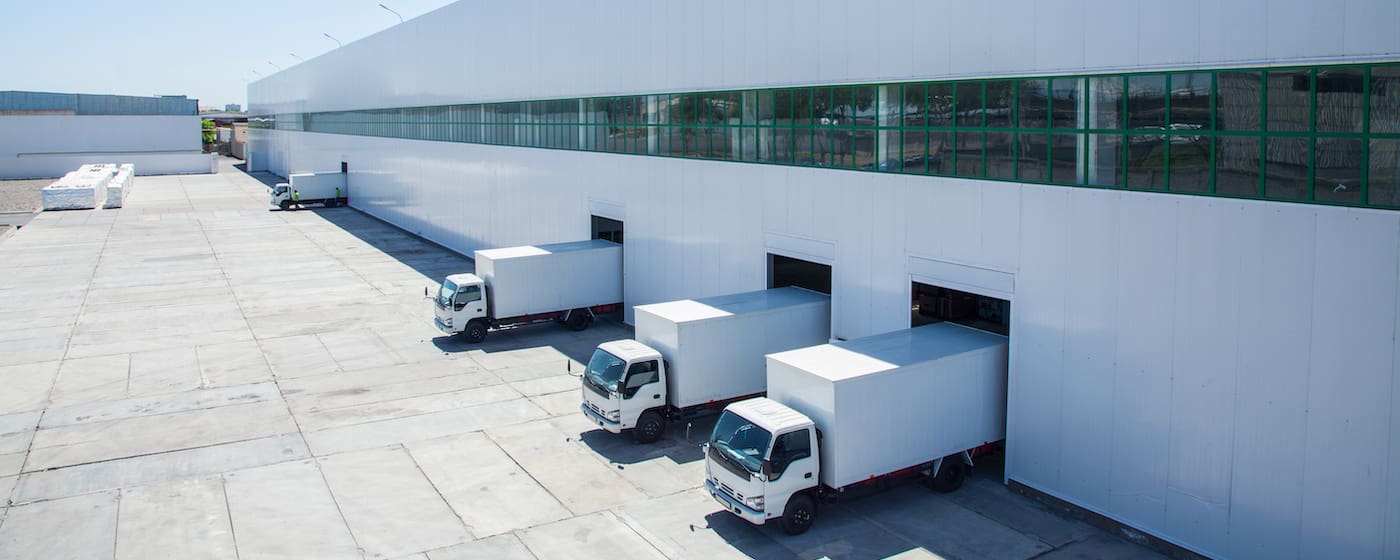Table of Contents
** Minutes
What is a distribution warehouse?
The role of technology in distribution warehouses
Challenges in traditional warehousing
Best practices for distribution warehouses
Optimize everything with ShipBob’s WMS and fulfillment services
Every growing online business will at some point face the challenging task of navigating distribution logistics and warehouse management.
Gone are the days of managing one warehouse using spreadsheets if you want to reach more customers across locations faster and affordably.
Now more than ever, warehouse technology is being introduced to improve warehouse productivity, allowing for more extensive warehouse distribution.
In this article, we take a closer look at how technology allows for warehouse distribution, and how it supports ecommerce businesses looking to scale their operations.
What is a distribution warehouse?
A distribution warehouse (or distribution center) is used to store ready-to-sell inventory until items are ready to fulfilled. In most cases, there are more than one distribution warehouse within a single network.
This type of warehouse is mostly designed for short-term storage and faster inventory flow, which means that inbound goods are only stored for a short period of time before they’re shipped out to a retail location or to the end customer.
Unlike traditional warehousing, warehouse distribution is supported by a warehouse management system (WMS) and/or inventory management system to track inventory and warehouse productivity across distribution locations in real time.
The role of technology in distribution warehouses
To function properly within the ecommerce supply chain, distribution warehouses are powered by the latest technology to improve accuracy, productivity, and inventory flow across locations.
With smart warehousing being the new standard, this new era of warehousing is capable of inventory optimization to ensure there is enough product in each location for a period of time to meet demand.
It can also reduce risk, including less picking errors, inventory shrinkage, and slow fulfillment.
Here is an overview of how technology plays a role in warehouse distribution.
Optimized inventory management
In distribution warehousing, inventory management software is integrated with a WMS to improve visibility, from warehouse receiving to fulfillment, to returns management.
This technology gives business operations full visibility into inventory, so you know exactly how many items on the SKU level you have left, where your inventory is stored, and how much inventory is sold in real time.
Based on this information, you can get a clear picture of your inventory needs and monitor inventory replenishment faster to stay on top of demand while optimizing warehouse capacity.
With optimized inventory tracking, you can get SKU-level insights into how your inventory is performing, i.e., which items are slow to sell and which ones are selling out fast, and you can make adjustments to meet demand and increase profits.
Faster and better order fulfillment
Technology is used in distribution warehouses to improve warehouse efficiency and optimize the fulfillment process.
Using modern WMS technology, you can sync your online store, so that orders are automatically sent to the fulfillment center as soon as they come in, which jumpstarts the order fulfillment process.
Picking lists are automatically generated, which identifies optimal routes so pickers can locate and pick items in the most efficient manner.
Some warehouse distribution technology is enabled to compare rates and shipping speeds between different carrier partners, which will allow you to easily choose the most suitable carrier for each shipment.
Cost and wastage reduction
Since warehouse distribution technology is designed to optimized inventory levels, businesses are also able to reduce risk of product spoilage and accumulating obsolete inventory (often known as deadstock).
Another way it can cut down costs is through box selection technology, which recommends the optimal box size for each shipment. This helps to minimize packing costs while reducing packaging waste.
Challenges in traditional warehousing
Traditional ecommerce warehousing comes with a number of challenges, including lack of visibility, time-consuming tasks, inventory inaccuracies, and more.
In the past, businesses followed a straightforward rule of stocking as many units as possible for every product at all times to avoid the risk of stockouts and missed sales opportunities. But this always led to surplus inventory.
However, this is hardly sustainable today as it can inflate holding costs, which refers to the cost of storing inventory. Traditional warehousing also lacks the technology necessary to make better inventory decisions to meet demand while optimizing warehouse space.
Traditional warehousing also relied solely on a periodic inventory system, which consists of manually counting inventory. Relying on this system without the use of technology comes with higher risk of misplacing items, and it can take too long to locate items in the warehouse, slowing down the fulfillment process.
Overall, traditional warehousing is riddled with inefficiencies in terms of both time and costs. These warehousing challenges put a strain on the supply chain and may result in delays, reduced profits, and inventory accounting errors.
All the wasted time and expenses mean that your business won’t be making as much money as it potentially could. If left unaddressed, these challenges will eventually affect your bottom line and prevent your business from scaling.
Best practices for distribution warehouses
Transitioning from a traditional warehouse to a distributed warehousing model can be overwhelming. But there are steps you can take to break down the complexity.
Here are some best practices to follow.
Adopt a WMS
Using a WMS in your distribution warehouses is key. It provides visibility and stronger inventory control. The WMS is what will drive processes within the warehouse — from receiving and storage to picking and packing — and improve accuracy, data management, and productivity.
A WMS will also help your team automate time-consuming tasks that are alone prone to human error, such as locating the right items in the warehouse for orders or conducting accurate inventory audits.
For example, ShipBob’s WMS has proven to:
- Reduce picking errors by 35% while increasing fulfillment speed by 130%.
- Seamlessly grow 1,500% to 35k+ orders per month and scale 2 warehouses.
- Save 10% on in-house fulfillment.
- Reach 99.7% order accuracy while eliminating 2,100 mispicks annually.
“We went from 3-4 people spending all day packing orders, and now we have our manager doing everything herself. She picks and packs orders from 7:00 am to noon, and then she’s done with DTC orders for the day. And now our team doesn’t have to rely on tribal knowledge for anything! We can rely on the automated system.
All we have to do is scan the order, go where the system tells us, pick the item, then pack it. It’s way less stressful than our previous system. ShipBob has saved us time and labor costs.”
Adam LaGesse, Global Warehousing Director at Spikeball
Use inventory management software
Integrating inventory management software with a WMS allows for deeper inventory data and automates inventory counts in real time.
This helps with inventory replenishment as you can reorder the right quantities of stock at the right time to prevent stockouts and excess inventory. It also ensures that you don’t accidentally sell items that are already out of stock.
It also uses historical sales data and consumer buying behavior to make accurate predictions about inventory demand. That way, you don’t stock up on more inventory than you need, which could take up precious warehouse space and cost you thousands of dollars in storage costs and deadstock.
With the right inventory management software, you can even set reorder points. That way, the system will automatically send you a notification when your stock dips below the pre-determined level, giving you ample time to replenish inventory.
If you’re distributing inventory between different fulfillment centers, you can also use the software to strategically plan your distribution. That way, you can store your inventory closer to customers and ensure that all the fulfillment centers are optimally stocked at all times.
“With ShipBob’s WMS, we can create the most efficient routes through the warehouse, which has cut down on an insane amount of time and made picking, packing, and shipping so much more efficient. Running a warehouse is unpredictable. But ShipBob has definitely helped with that.”
Jourdan Davis, Operations Manager at Pit Viper
Report on and track inventory levels and operations efficiency
When using technology to provide real-time data and visibility, you’re given access to historical inventory data to make better business decisions.
Enhanced inventory reporting helps your business decide:
- How much inventory to stock based on SKU data
- What location(s) to store inventory in based on demand
- The frequency of inventory replenishment based on space, costs, and demand
- And much more.
Aside from tracking inventory, a WMS can also help track warehouse productivity, so you can identify problem areas and inefficiencies and optimize them.
This allow you to make continuous improvements, which will ultimately improve your bottom line and increase customer satisfaction.
“ShipBob’s WMS has more than doubled, if not tripled, our productivity in terms of labor hours. Our average days to ship is now only 0.8 days, so most packages are shipping same-day or next-day, with rare exceptions.
We’ve cut 4 days of lead time because orders are getting processed, fulfilled, and shipped more efficiently. When we first started with ShipBob, we were doing about 15K orders per month, and now we’re processing 30K — double what we were doing just six months ago.”
Ben Tietje, Co-Founder and CEO of Earthley
Optimize everything with ShipBob’s WMS and fulfillment services
Whether you’re fulfilling orders directly to the end customers or partnering with retail distributors, ShipBob helps you optimize your entire fulfillment strategy with world-leading fulfillment solutions.
When you choose ShipBob’s 3PL distribution services, you can outsource all the complex distribution and fulfillment processes to the experts. This includes everything from managing and storing your inventory to picking and packing orders. With ShipBob’s expertise, you can expect to significantly speed up fulfillment time and accuracy.
“For us, changing from a 3 week lead time to 3 days through ShipBob is what drove our sales. Even now, one of the primary reviews we get on Etsy is, ‘My order arrived really quickly!’ Having the stock locally in the US means that lead times and shipping times are minimal, and that you’ll get higher conversion rates because you’re offering better lead times.”
John Greenhalgh, Co-Founder of A Year of Dates
The ShipBob WMS seamlessly integrates with multiple sales channels, which will allow you to optimize omnichannel distribution.
That way, customers can purchase from anywhere they choose — be it your own website or through their favorite retail website. ShipBob can fulfill wholesale orders and ship inventory directly to your retail distribution partners.
“Learning to tailor our sales strategy, marketing, and packaging to each retailer’s requirements has been a challenge, but that’s where ShipBob really comes in handy. ShipBob is EDI-compliant with dozens of popular retailers, and their API integrations make it possible for them to fulfill orders according to each retailer’s compliance guidelines.”
Aaron Patterson, COO of The Adventure Challenge
If you’re managing your own warehouse, you can also implement ShipBob’s warehouse management system to optimize your operations.
This comes with a comprehensive set of tools that will help you with warehouse operations management, inventory management, order management, picking and packing, and reporting and analytics to name a few.
That way, you still have full control over your warehousing operations while getting better visibility and tools to improve efficiency.
“When we had an issue with one of the pick processes, I brought it up to a member of ShipBob’s team — and three days later, they had completely solved the issue not just for us, but for every one of their customers. I can’t think of any SaaS provider who would have fixed a problem like that within a couple of days, bar none. ShipBob is knocking it out of the park.”
Ben Tietje, Co-Founder and CEO of Earthley
Warehouse distribution FAQs
Below are answers to the most common questions about warehouse distribution.
How does warehouse distribution differ from traditional retail distribution?
In warehouse distribution, goods are stored in more than one location and is tracked using technology like inventory management software and warehouse management systems. This allows for visibility across distribution location, real-time inventory tracking, and warehouse productivity monitoring.
How can technology be used to optimize warehouse distribution processes?
Technology can help businesses strategically plan how to distribute their inventory between different locations based on demand. It can also give them accurate and real-time inventory visibility, which will improve their inventory management and replenishment strategy. Furthermore, technology can help automate time-consuming warehousing tasks, which then improves speed and accuracy.
How can ShipBob help with warehouse distribution?
ShipBob offers a cloud-based WMS that businesses can implement into their own warehouse. This gives businesses access to warehouse management tools, including inventory tracking, order fulfillment metrics, and more. Alternatively, you can choose to store inventory in one or more of ShipBob’s fulfillment locations.



